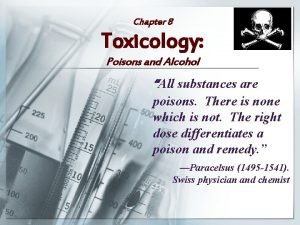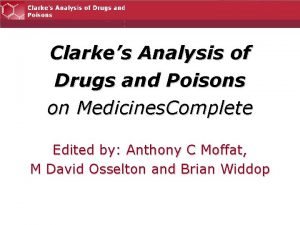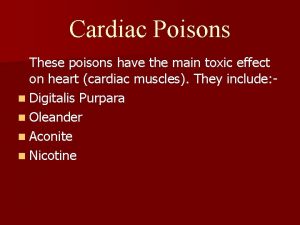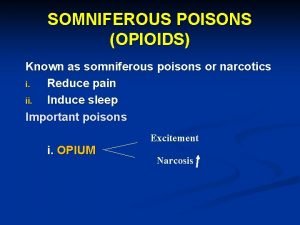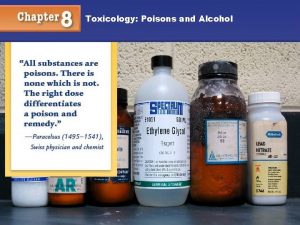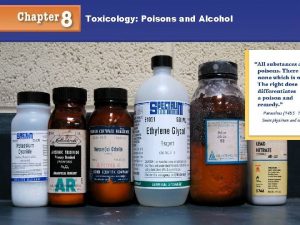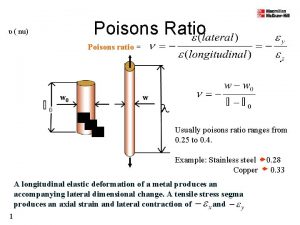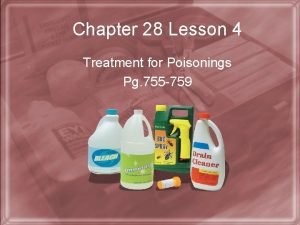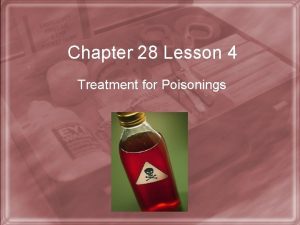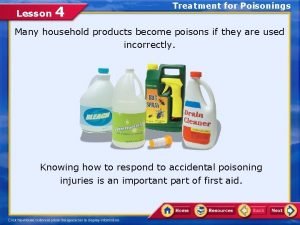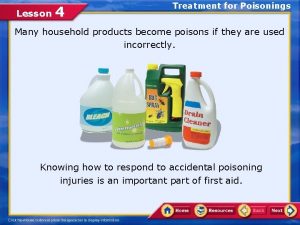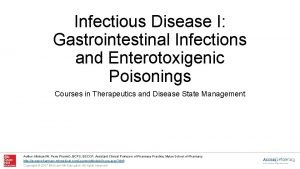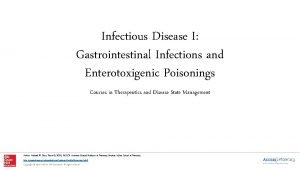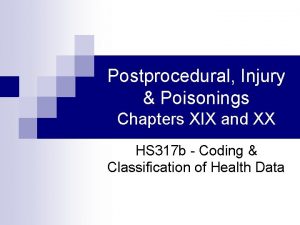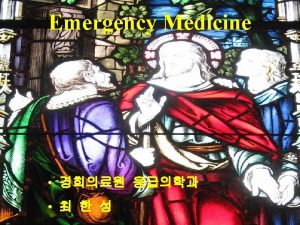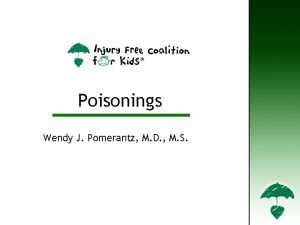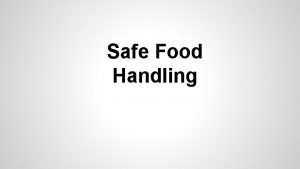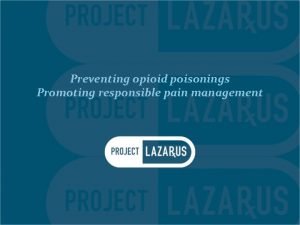Chapter 35 lesson 2 Poisonings Poisons 1 and



















- Slides: 19

Chapter 35 lesson 2 Poisonings

Poisons • 1 and 2 million poisonings occur in the United states every year • ½ of poisonings involve medicines and household products that are swallowed or inhaled • Poisoning can also result from insect or animal bites and even from touching certain substances, such as poison ivy • Most poisonings involve children under 6

Swallowing Poison • • Symptoms of swallowing poison Sharp abdominal cramps Extreme drowsiness Loss of consciousness Vomiting Chemical odor on breath Chemical burns on lips Open container

First Aid for Swallowing Poison • Call poison control center • Be prepared to give information about victim and poison • May be told to give milk or water to dilute poison • May be told to give Emetic to induce vomiting, such as teaspoon of table salt with warm water • Treat victim for shock

Snakebite • • 4 poisonous types in United States Rattle snake Copperhead Water moccasin (cotton mouth) Coral snake ½ of all poisonous snakebites occur in Texas, Louisiana, North Carolina, Florida, Georgia, Arkansas

Snakebite • 1% of the people bitten by poisonous snakes die • A large number of deformities and amputations do result from poisonous snake bites

Rattle Snake

Copperhead

Water Moccasin

Coral Snake

First Aid for Snake Bite • Get Victim to Hospital • Keep bitten area at or below the level of the heart • Call, or have someone call, EMS • Delay the absorption for venom • Maintaining breathing and prevent aggravation of the wound

Contact Poisoning • 2 categories • Plants • Chemicals

First Aid for Plants • Poison ivy, Poison oak, Poison sumac • First defense is to learn what they look like • Some have no reaction, others develop severe skin rash, followed later by blistering, swelling, burning, itching and perhaps fever

Poison Ivy

Poison oak

Poison sumac

First Aid for Plants • 1 – Remove contaminated clothing • 2 – Pour large quantities of water over the affected area • 3 – Wash area thoroughly with soap and water • 4 – Calamine lotion can be used to relieve the itching • 5 – If pain severe, seek medical attention

First Aid for Poisonous Chemicals • Pesticides, solvents, household cleaning supplies, and highly abrasive cleaners are among the chemicals that can cause poisoning • Chemical poisoning through direct contact with a chemical is usually characterized by a burning of the skin, like a sunburn

First Aid for Poisonous Chemicals • 1 – remove clothing that has come into contact with the chemical • 2 – Flooding the area with water for 15 minutes • 3 – Contact the nearest poison control center
 Chapter 8 toxicology poisons and alcohol
Chapter 8 toxicology poisons and alcohol Toxicology types
Toxicology types Clarke's analysis of drugs and poisons
Clarke's analysis of drugs and poisons Cardiac poison
Cardiac poison Somniferous poisons
Somniferous poisons Erythism
Erythism What is an overall state of well-being or total health
What is an overall state of well-being or total health Difference between micro and macro lesson plan
Difference between micro and macro lesson plan Sat vocabulary lesson and practice lesson 4
Sat vocabulary lesson and practice lesson 4 Lesson 1 thermal energy and the behavior of matter
Lesson 1 thermal energy and the behavior of matter Lesson 4 gravity and motion lesson review
Lesson 4 gravity and motion lesson review Magnets and magnetic fields lesson 1 answer key
Magnets and magnetic fields lesson 1 answer key Lesson outline lesson 3 eclipses and tides answer key
Lesson outline lesson 3 eclipses and tides answer key Lesson outline lesson 3 describing circuits answers
Lesson outline lesson 3 describing circuits answers Mountain building
Mountain building Lesson outline lesson 2 aquatic ecosystems answer key
Lesson outline lesson 2 aquatic ecosystems answer key Ihi l 101
Ihi l 101 Where did ravi hide the kitten?
Where did ravi hide the kitten? Weather forecast lesson 3 outline answers
Weather forecast lesson 3 outline answers Lesson 2 physical properties answer key
Lesson 2 physical properties answer key
